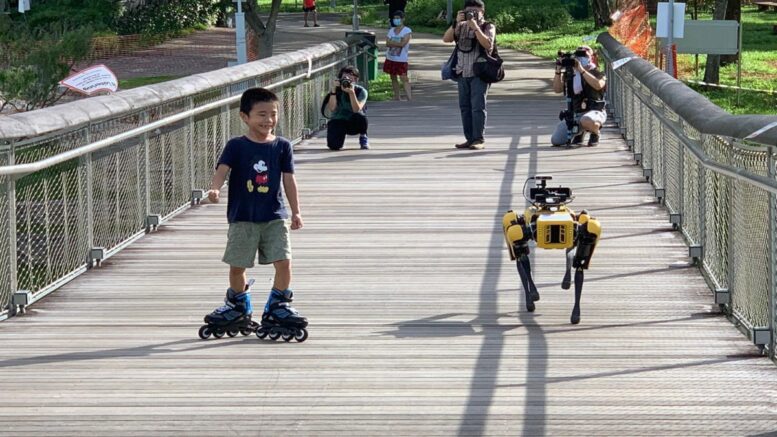Police Robots Are Being Used For Social Distancing Control
Jun 27, 2020 14:54:22 #
If robots are being implemented elsewhere in the world to help police with enforcement of social distancing and face mask compliance, you can bet your bottom dollar that America will soon follow suit. Technocrats have an engineered answer for every conceivable problem. Patrick Wood
Police Robots Are Being Used For Social Distancing Control
Muhammad Faizal Abdul Rahman ~ June 23, 2020

C****-** is accelerating the adoption of police robots in several cities such as Tunis in Tunisia, Guangzhou in China, and Chennai in India.
In south-east Asia, the city-state of Singapore leverages its Smart Nation resources to alleviate shocks from C****-**. The robot car O-R3 and robot dog Spot patrol public parks and broadcast messages that remind people to maintain safe-distancing. The police robots "Matar” patrol a migrant worker dormitory and government quarantine facility. Autonomous drones patrol the skies above industrial zones, which are deserted due to the city-state’s lockdown, to deter opportunistic criminals.
Globally, the p******c is compelling police forces to navigate more challenges. In the United States, inadequate protective gear exposes police officers to the risk of contracting the disease. In Australia, frontline workers, including police officers, encounter incidents of “spitting attacks”. In Singapore, a person knifed an enforcement officer who was performing safe-distancing duties.
The p******c, which is the first to ravage the world in the Industry 4.0 era, offers an opportunity for police forces to boost smart policing in keeping pace with the changing world. Old methods of policing are insufficient to ease the unprecedented pressures from additional duties to support p******c controls while concomitantly fighting crime. Across emergency services, Industry 4.0 technologies such as robots are shifting from novelty to necessity.
The World Economic Forum describes robots as “a game-changer in p******cs” and “can provide contact-free alternatives”. Robots can help enforce quarantines and safe-distancing as they are not susceptible to fatigue and disease. They can ease the physical and mental pressures that police officers face while working extended long hours in high-risk environments. This benefit extends to other government officers who are empowered by public health laws to enforce p******c controls.
Smart policing for new normal
The challenges that police forces encounter today could evolve and shape the new normal in the post-p******c reality. Health experts warned that C****-** could linger after the p******c ends. The economic recession that follows could exacerbate socio-political tensions in some cities, hence creating conditions for unrest and terrorism. To address these challenges, it requires more than deploying more robots as boots on the ground.
To fully realize smart policing, police forces should enhance the integration of robots in three areas. Firstly, police forces should review their operational processes to include doctrines that guide the use of robots in frontline duties. Robot operators should coordinate with police intelligence units to ensure real-time analytics of the data that robots collect while patrolling. They should also be mindful of the legal and ethical issues that could arise from human-robot interactions.
For example, what should the operator do if a malfunction or accident causes the robot to harm a human? How should the operator respond if a troubled person approaches the robot for police assistance? Procedures must also be in place to protect the robots as they support civilian policing and hence may lack defensive capabilities, unlike military robots.
Secondly, an organization-wide culture of innovation could ensure that robots become the enablers they should be. If robots create more work than benefits, they could fall into disuse as police officers grow to distrust them. This problem hindered the adoption of service robots in a Japanese hotel. To promote such a culture, Singapore, for example, established the Home Team Science and Technology Agency in 2019.
This culture should also foster collaboration with academia, industry and foreign police forces that share similar operational conditions. Existing collaboration platforms, such as the INTERPOL World Conference in Singapore, could support police forces in appreciating the legal and ethical issues stemming from the growing use of robots.
Thirdly, police forces should examine how robots could support or impair their community engagements. This issue is particularly critical for cities where trust between police officers and the public is lower due to a history of excessive use of force or ethnic discrimination. Robots may lack the human touch. The sight of them patrolling the streets could create fears that the police force is becoming militarised and more inclined to use force to solve problems.
Furthermore, police forces are susceptible to misinformation that ride on the distrust of governments, casting aspersions on police actions. Especially now, G****e F***d’s death in the US and anti-protest enforcement in Hong Kong could sully the reputation of police officers everywhere. The use of robots in cities should come with trust-building messages in the media to dispel concerns that a dystopian future looms.
In conclusion, the C****-** p******c may be the inflexion point for robots to revolutionize policing, looking ahead. History shows that new technologies, such as the two-way radio and automobile in the 1930 and 1940s, can t***sform policing strategies for the better. By integrating robots well into police forces, they can become smart assistants of police officers for frontline duties that carry significant risks and stress for humans.
Police Robots Are Being Used For Social Distancing Control
Muhammad Faizal Abdul Rahman ~ June 23, 2020

C****-** is accelerating the adoption of police robots in several cities such as Tunis in Tunisia, Guangzhou in China, and Chennai in India.
In south-east Asia, the city-state of Singapore leverages its Smart Nation resources to alleviate shocks from C****-**. The robot car O-R3 and robot dog Spot patrol public parks and broadcast messages that remind people to maintain safe-distancing. The police robots "Matar” patrol a migrant worker dormitory and government quarantine facility. Autonomous drones patrol the skies above industrial zones, which are deserted due to the city-state’s lockdown, to deter opportunistic criminals.
Globally, the p******c is compelling police forces to navigate more challenges. In the United States, inadequate protective gear exposes police officers to the risk of contracting the disease. In Australia, frontline workers, including police officers, encounter incidents of “spitting attacks”. In Singapore, a person knifed an enforcement officer who was performing safe-distancing duties.
The p******c, which is the first to ravage the world in the Industry 4.0 era, offers an opportunity for police forces to boost smart policing in keeping pace with the changing world. Old methods of policing are insufficient to ease the unprecedented pressures from additional duties to support p******c controls while concomitantly fighting crime. Across emergency services, Industry 4.0 technologies such as robots are shifting from novelty to necessity.
The World Economic Forum describes robots as “a game-changer in p******cs” and “can provide contact-free alternatives”. Robots can help enforce quarantines and safe-distancing as they are not susceptible to fatigue and disease. They can ease the physical and mental pressures that police officers face while working extended long hours in high-risk environments. This benefit extends to other government officers who are empowered by public health laws to enforce p******c controls.
Smart policing for new normal
The challenges that police forces encounter today could evolve and shape the new normal in the post-p******c reality. Health experts warned that C****-** could linger after the p******c ends. The economic recession that follows could exacerbate socio-political tensions in some cities, hence creating conditions for unrest and terrorism. To address these challenges, it requires more than deploying more robots as boots on the ground.
To fully realize smart policing, police forces should enhance the integration of robots in three areas. Firstly, police forces should review their operational processes to include doctrines that guide the use of robots in frontline duties. Robot operators should coordinate with police intelligence units to ensure real-time analytics of the data that robots collect while patrolling. They should also be mindful of the legal and ethical issues that could arise from human-robot interactions.
For example, what should the operator do if a malfunction or accident causes the robot to harm a human? How should the operator respond if a troubled person approaches the robot for police assistance? Procedures must also be in place to protect the robots as they support civilian policing and hence may lack defensive capabilities, unlike military robots.
Secondly, an organization-wide culture of innovation could ensure that robots become the enablers they should be. If robots create more work than benefits, they could fall into disuse as police officers grow to distrust them. This problem hindered the adoption of service robots in a Japanese hotel. To promote such a culture, Singapore, for example, established the Home Team Science and Technology Agency in 2019.
This culture should also foster collaboration with academia, industry and foreign police forces that share similar operational conditions. Existing collaboration platforms, such as the INTERPOL World Conference in Singapore, could support police forces in appreciating the legal and ethical issues stemming from the growing use of robots.
Thirdly, police forces should examine how robots could support or impair their community engagements. This issue is particularly critical for cities where trust between police officers and the public is lower due to a history of excessive use of force or ethnic discrimination. Robots may lack the human touch. The sight of them patrolling the streets could create fears that the police force is becoming militarised and more inclined to use force to solve problems.
Furthermore, police forces are susceptible to misinformation that ride on the distrust of governments, casting aspersions on police actions. Especially now, G****e F***d’s death in the US and anti-protest enforcement in Hong Kong could sully the reputation of police officers everywhere. The use of robots in cities should come with trust-building messages in the media to dispel concerns that a dystopian future looms.
In conclusion, the C****-** p******c may be the inflexion point for robots to revolutionize policing, looking ahead. History shows that new technologies, such as the two-way radio and automobile in the 1930 and 1940s, can t***sform policing strategies for the better. By integrating robots well into police forces, they can become smart assistants of police officers for frontline duties that carry significant risks and stress for humans.
Jun 27, 2020 20:25:26 #
Parky60 wrote:
i If robots are being implemented elsewhere in th... (show quote)
Cheers to the boys in blue for being proactive about the future



If you want to reply, then register here. Registration is free and your account is created instantly, so you can post right away.

